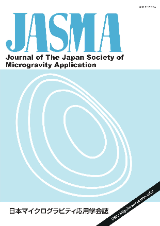Volume 29, Issue 3
Expanding KIBO utilization
Displaying 1-9 of 9 articles from this issue
- |<
- <
- 1
- >
- >|
-
2012Volume 29Issue 3 Pages 104-
Published: July 31, 2012
Released on J-STAGE: January 21, 2021
Download PDF (369K) -
2012Volume 29Issue 3 Pages 106-
Published: July 31, 2012
Released on J-STAGE: January 21, 2021
Download PDF (843K) -
2012Volume 29Issue 3 Pages 111-
Published: July 31, 2012
Released on J-STAGE: January 21, 2021
Download PDF (1202K) -
2012Volume 29Issue 3 Pages 120-
Published: July 31, 2012
Released on J-STAGE: January 21, 2021
Download PDF (680K) -
2012Volume 29Issue 3 Pages 125-
Published: July 31, 2012
Released on J-STAGE: January 21, 2021
Download PDF (1221K) -
2012Volume 29Issue 3 Pages 132-
Published: July 31, 2012
Released on J-STAGE: January 21, 2021
Download PDF (942K) -
2012Volume 29Issue 3 Pages 138-
Published: July 31, 2012
Released on J-STAGE: January 21, 2021
Download PDF (1354K) -
2012Volume 29Issue 3 Pages 147-
Published: July 31, 2012
Released on J-STAGE: January 21, 2021
Download PDF (874K) -
2012Volume 29Issue 3 Pages 154-
Published: July 31, 2012
Released on J-STAGE: January 21, 2021
Download PDF (848K)
- |<
- <
- 1
- >
- >|
